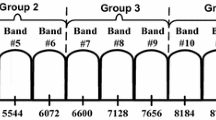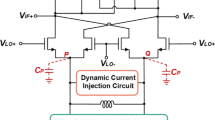Abstract
A new design of CMOS doubly-balanced down-conversion mixer intended for Multiband Orthogonal Frequency Division Multiplexing (MB-OFDM) receiver of UWB group#1 bands and optimized for 0.35-μm technology is presented. The proposed mixer uses the current-bleeding technique in both the driver and switching stages with wideband impedance matching, consisting of a bandpass filter embedding the RF stage. The mixer performances are optimized for the AMS 0.35 μm CMOS process parameters. Over 3.1–4.8 GHz, the circuit drawing 6 mA from 3-V supply, shows a conversion gain of 14.0±1.0 dB, IIP3 of 0±2 dBm, doubly-sideband noise figure of 4.5–4.8 dB, and port-to-port isolation above 61.0 dB.
Similar content being viewed by others
References
ECMA (2005). Standard ECMA-368: High rate ultra wideband PHY and MAC standard. December, 2005.
Lee S.G., Choi J.-K. (2000). Current-reuse bleeding mixer. Electronics Letters 36:696–697
Phan A.T., Kim C.W., Shim Y.A., Lee S.G. (2005). A high performance CMOS direct down conversion mixer for UWB system. IEICE Transactions Electronics E88:4372–4380
Gharpurey, R. (2005, June). Design challenges in emerging broadband wireless systems. Paper Presented at IEEE Radio Frequency Integrated Circuits (RFIC) Symposium. Digest of Technical Papers, pp. 331–334.
Ismail A., Abidi A.A. (2005). A 3.1–8.2 GHz Zero-IF receiver and direct frequency synthesizer in 0.18 μm SiGe BiCMOS for mode-2 MB-OFDM UWB communication. IEEE Journal of Solid-State Circuits 40(12):2573–2582
Sung, C.-C., Chou, M.-F., Wu, C.-C., Chen, C.-S., Wen, K.-A., & Chang, C.-Y. (2004, December). Low power CMOS wideband receiver design. Paper Presented at The 16th International Conference on Microelectronics, ICM’2004, pp. 287–290.
Lee S.-G., et al. (2000). Current-reuse bleeding mixer. Electronics Letters 36(8):6960–6697
Touati, F., Douss, S., & Loulou, M. (2007, February). A 3.1–5 GHz CMOS active mixer for UWB IEEE 802.15.3a standard receivers. Paper Presented at the International Conference on Communication, Computer and Power ICCCP’07, pp. 6–10.
Park J., Lee C.-H., Kim B.-S., Laskar J. (2006). Design and analysis of low flicker-noise CMOS mixers for direct-conversion receivers. IEEE Transactions on Microwave Theory and Techniques 54:4372–4380
Darabi H., Abidi A.A. (2000). Noise in RF-CMOS mixers: A simple physical model. IEEE Journal of Solid-State Circuits 35(1):15–25
MacEachern, L. A., & Manku, T. (1998, May). A charge-injection method for Gilbert cell biasing. Paper Presented at IEEE Canadian Conference on Electrical and Computer Engineering, pp. 365–368.
Wu T.-H., Tseng S.-C., Meng C.-C., Huang G.-W. (2007). GaInP/GaAs HBT sub-harmonic Gilbert mixers using stacked-LO and leveled-LO topologies. IEEE Trans. Microwave Theory and Techniques 55(5):880–889
Author information
Authors and Affiliations
Corresponding author
Rights and permissions
About this article
Cite this article
Touati, F., Douss, S. & Loulou, M. A High-Performance Doubly-Balanced Mixer in 0.35-μm CMOS for Mode-1 MB-OFDM UWB Receivers. Wireless Pers Commun 46, 351–363 (2008). https://doi.org/10.1007/s11277-007-9438-1
Received:
Accepted:
Published:
Issue Date:
DOI: https://doi.org/10.1007/s11277-007-9438-1




